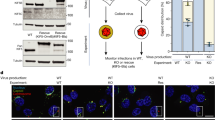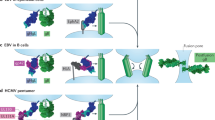Abstract
IN previous studies1 on the growth of the HFEM strain of herpes virus in HeLa cells, attempts were made to estimate the proportion of infected cells by inoculating the intact calls on to the chorioallantois of fertile hens' eggs and determining the number which formed pocks. It is known that the chorioallantois is at least ten times more sensitive than HeLa cells to this strain of virus released from HeLa cells. Nevertheless, the proportion of infected (pock-forming) cells was much lower than would be expected from the deduced input of HeLa infective virus, and it was concluded that the cells might not survive long enough to make virus in this environment.
This is a preview of subscription content, access via your institution
Access options
Subscribe to this journal
Receive 51 print issues and online access
$199.00 per year
only $3.90 per issue
Buy this article
- Purchase on Springer Link
- Instant access to full article PDF
Prices may be subject to local taxes which are calculated during checkout
Similar content being viewed by others
References
Stoker, M. G. P., and Ross, R. W., J. Gen. Microbiol., 19, 250 (1958).
Wildy, P., Stoker, M. G. P., and Ross, R. W., J. Gen. Microbiol. (in the press).
Farnham, A. E., Virology (in the press).
Stoker, M. G. P., Soc. Gen. Microbiol. Symp., “Virus Growth and Variation” (in the press).
Ross, R. W., and Orlans, E., J. Path. Bact., 76, 393 (1958).
Author information
Authors and Affiliations
Rights and permissions
About this article
Cite this article
STOKER, M. Mode of Intercellular Transfer of Herpes Virus. Nature 182, 1525–1526 (1958). https://doi.org/10.1038/1821525a0
Issue Date:
DOI: https://doi.org/10.1038/1821525a0
This article is cited by
-
Effects of a pathogenic canine herpesvirus on canine brain cell cultures and cerebellar explants
Acta Neuropathologica (1970)
-
Viral Aetiology of Human Tumours
Nature (1968)
-
Mikrokinematographisehe Studien �ber die Entstehung von Riesenzellen durch Herpes-B-Virus in Zellkulturen
Archiv f�r die gesamte Virusforschung (1961)
Comments
By submitting a comment you agree to abide by our Terms and Community Guidelines. If you find something abusive or that does not comply with our terms or guidelines please flag it as inappropriate.



